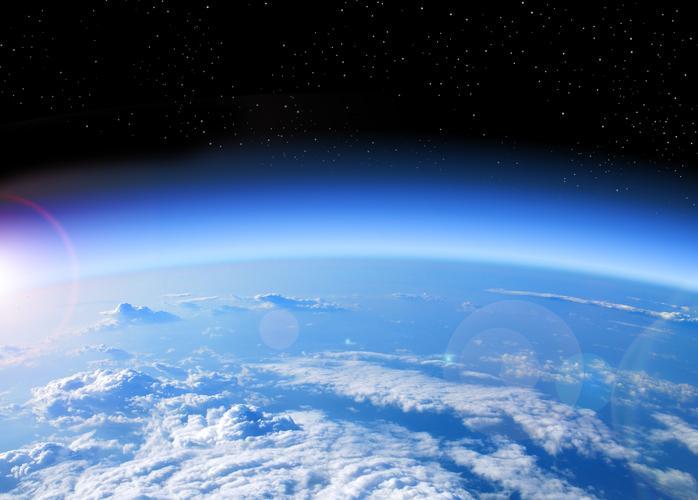What Is Tropospheric Ozone?


Unlike car exhaust fumes that dissipate quickly, ozone is a hidden danger lurking in our air. This gas isn't directly emitted, but rather forms when pollutants react under specific conditions, like sunshine. The result? Ozone, which can travel long distances and pose a significant health risk. According to the World Health Organization (WHO), a staggering 82% of the world population is impacted by ozone, with negative effects on both human health and crop productivity.
In this article by thedailyECO, dives deep into what tropospheric ozone is, its formation, its impact on our environment, and what we can do about it.
What is tropospheric ozone and how is it formed?
Ozone (O3) is a molecule comprised of three oxygen atoms. Unlike the odorless oxygen (O2) vital for life, ozone has a faint, sharp scent, sometimes mistaken for chlorine. This gas plays a fascinating double role in our atmosphere.
High above Earth's surface lies the stratosphere. Here, ozone acts as a benevolent protector, absorbing harmful ultraviolet (UV) radiation from the sun. This vital layer shields life on Earth from the damaging effects of UV rays.
Closer to home, in the troposphere, ozone takes on a villainous role. Unlike its stratospheric counterpart, here it becomes a pollutant. This harmful byproduct arises from complex photochemical reactions, similar to smog formation. These reactions occur when sunlight interacts with nitrogen oxides (NOx) and volatile organic compounds (VOCs) – a nasty cocktail brewing in our atmosphere.
The primary source of NOx is vehicle exhaust, particularly during heavy traffic periods. VOCs, on the other hand, emanate from a wider range of culprits: refineries and chemical plants, paints and cleaning products, gas stations, and even industrial processes. Methane (CH4), though not directly involved in ozone formation, adds to the overall air quality woes. Its sources include natural gas production, burning of biomass (forest fires, agricultural practices), decomposition in landfills and wastewater treatment, and activities like coal mining and livestock farming.
The spread of tropospheric ozone is a complex interplay of several factors. Sunlight acts as the conductor, orchestrating the photochemical reactions that create ozone. The greater the concentration of NOx and VOCs (the pollutants we discussed earlier), the more likely ozone formation becomes. Then, wind patterns then come into play, acting as a transporter, carrying ozone and its precursors over long distances, impacting areas downwind.
This intricate web of interactions can lead to surprisingly high ozone levels in suburbs and downwind areas compared to city centers.
It's important to note that while NO can also remove ozone under certain conditions, the overall effect of these factors determines the final distribution. In the following section, we'll explore the detrimental effects of tropospheric ozone on human health and the environment, highlighting the consequences of this "bad" ozone.

Tropospheric ozone: impact on human health
Tropospheric ozone poses a significant health risk, causing a range of undesirable effects, especially during summer months. Studies have linked ozone exposure to several short-term health problems:
- Lung inflammation: ozone can irritate and damage the lining of the lungs, leading to inflammation.
- Respiratory issues: this irritation can lead to difficulty breathing (respiratory insufficiency), worsening asthma symptoms, and increased susceptibility to bronchopulmonary diseases.
- Cough and irritation: coughing, irritation of the throat and pharynx (the back of the throat), and eye irritation are common symptoms.
- Decreased lung function: ozone exposure can reduce lung capacity, making it harder to breathe.
- General discomfort: exposure can also cause general discomfort and a feeling of being unwell.
Beyond these immediate effects, research suggests a link between ozone exposure and increased mortality rates. Additionally, some studies point towards a potential long-term impact on reproductive health.
Since 2005, research has explored the connection between ozone exposure and respiratory deaths through cohort studies. It's important to note that the International Agency for Research on Cancer classifies environmental pollution, of which ozone is a component, as a Group 1 carcinogen, the highest risk category.
Furthermore, ozone can interact with other pollutants in the air, such as acetaldehyde, formaldehyde, and organic acids. These interactions create short-lived pollutants that can cause irritation and additional health effects.

How does tropospheric ozone impact ecosystems
High ozone levels aren't just a threat to human health; they also wreak havoc on vegetation. This harmful gas damages plants, impacting their reproduction, development, and overall health. The consequences are far-reaching, leading to:
- Decreased biodiversity: damaged plants struggle to survive, reducing the variety of plant life in an ecosystem. This can disrupt food webs and ecological balance.
- Slower forest growth: ozone exposure hinders the growth rate of forests, impacting their ability to store carbon dioxide.
- Reduced crop yields: ozone can significantly decrease the yield of various crops, particularly those sensitive to ozone pollution like tomatoes, lettuce, and cotton.
- Increased susceptibility: ozone exposure makes plants more vulnerable to other environmental stresses like drought, disease, and insect damage.
- Reduced photosynthesis: ozone disrupts the process by which plants capture sunlight and convert it to energy. This weakens the plant and limits its ability to thrive.
Several factors influence the severity of ozone damage on plants:
- Age: younger plants are often more susceptible.
- Light levels: plants exposed to higher light levels tend to be more affected.
- Soil conditions: the quality and nutrient content of the soil can play a role.
- Humidity: lower humidity levels can exacerbate ozone damage.
The detrimental effects of tropospheric ozone extend beyond the plant kingdom. While research is ongoing, there's growing evidence that animals can also suffer the consequences of high ozone levels. Here's a closer look at the potential threats:
- Similar to humans, animals with lungs might experience respiratory problems like irritation, inflammation, coughing, and difficulty breathing upon exposure to high ozone concentrations. This can increase their susceptibility to respiratory infections.
- Ozone exposure might compromise the immune system of animals, making them more vulnerable to various diseases and parasites.
- Studies suggest a link between ozone exposure and decreased reproductive success in some animal populations.
However, the key determinants are ozone concentration and the duration of exposure. New research suggests an even more complex interaction. Nitrogen, another air pollutant, can either lessen or worsen the effects of ozone on plants, making the overall impact unpredictable.
Finally, it's important to note that ozone ranks as the third most significant greenhouse gas after carbon dioxide and methane, further contributing to climate change.
What factors will increase ozone?
While significant amounts of NOx and VOCs are often emitted daily, the actual ozone levels can vary considerably. This variation depends on several key climatic conditions that act as a recipe for high ozone days:
- Sunlight plays a starring role in ozone formation. Higher levels of sunlight throughout the day accelerate the photochemical reactions that create ozone.
- Hot days with high maximum temperatures are prime conditions for ozone formation. Additionally, a larger daily temperature swing (high difference between minimum and maximum temperatures) can further contribute.
- Low humidity levels create an ideal environment for ozone to persist. Conversely, high humidity can hinder ozone formation.
- Strong winds can disperse ozone and its precursors, reducing ozone concentrations. Conversely, light winds allow ozone and its precursors to accumulate, leading to higher levels.
While the ozone layer high above protects us, tropospheric ozone poses environmental challenges. Interested in solutions for ozone depletion and improved air quality? Check out how can we fix the ozone layer for ideas that can make a difference.
If you want to read similar articles to What Is Tropospheric Ozone?, we recommend you visit our Environment (other) category.







